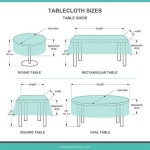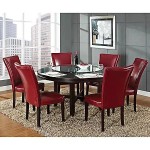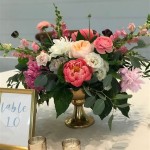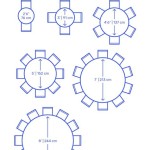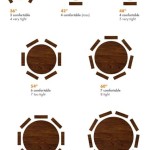Putting A Square Tablecloth On A Round Table: Achieving Aesthetic Harmony and Practical Functionality
Employing a square tablecloth upon a round table presents a unique design challenge. While a round tablecloth naturally complements the table's shape, a square tablecloth introduces angularity and formality. This approach, however, offers opportunities for creating visual interest, adding texture, and providing increased draping for a more dramatic presentation. Understanding the underlying principles of proportion, fabric choice, and arrangement techniques is essential to achieving a balanced and aesthetically pleasing outcome. This article explores various methods and considerations for successfully incorporating a square tablecloth onto a round table, focusing on achieving both visual harmony and practical functionality.
The motivation for choosing a square tablecloth over a round one can stem from several factors. Availability is a primary consideration; square tablecloths are often more readily available in specific fabrics, patterns, or sizes than their round counterparts. Cost-effectiveness can also play a role, as square tablecloths may be priced more favorably. Furthermore, a square tablecloth can introduce a desired level of formality or visual contrast that a round cloth might lack. The key lies in understanding how to effectively manage the excess fabric and create a balanced aesthetic that complements the table and the surrounding environment.
Understanding the Principles of Proportion and Scale
The successful implementation of a square tablecloth on a round table hinges on a firm understanding of proportion and scale. These principles dictate the relationship between the sizes and shapes of the tablecloth and the table, as well as their interaction with the surrounding space. A tablecloth that is too small will appear inadequate and fail to provide the necessary coverage, while one that is excessively large will overwhelm the table and create an unbalanced visual effect. Therefore, determining the appropriate size of the square tablecloth is paramount.
To determine the ideal size, the diameter of the round table must first be measured. This measurement serves as the baseline for calculating the desired drop of the tablecloth. The drop refers to the distance the fabric extends from the edge of the table downwards. A standard drop typically ranges from 8 to 12 inches, providing sufficient coverage without dragging on the floor. For a more formal or dramatic presentation, a longer drop, even reaching the floor, can be considered. However, this requires careful consideration of the surrounding space and the potential for tripping hazards. Once the desired drop is determined, it is doubled and added to the table's diameter. This sum represents the minimum recommended size for the square tablecloth.
For example, if a round table has a diameter of 48 inches and a desired drop of 10 inches is selected, the calculation would be as follows: 10 inches (drop) x 2 = 20 inches. Then, 48 inches (diameter) + 20 inches (total drop) = 68 inches. In this scenario, a square tablecloth with dimensions of at least 68 inches by 68 inches would be recommended. It is generally advisable to err on the side of slightly larger rather than smaller, as excess fabric can be more easily managed through various arrangement techniques. The selected size must also consider any existing elements in the room and their scale. For instance, in a small dining room, a floor-length tablecloth might feel too imposing, while in a larger space, it could add to the overall atmosphere of grandeur.
Fabric Choice and Texture Considerations
The choice of fabric significantly influences the overall aesthetic impact of a square tablecloth on a round table. Different fabrics possess varying textures, weights, and draping qualities, each contributing to a unique visual effect. Linen, for example, offers a natural, textured look that is both elegant and casual. Its inherent wrinkles add character and a sense of understated sophistication. Cotton is another popular choice, providing a soft and versatile option that is easy to care for. It is available in a wide range of colors and patterns, making it suitable for various styles and occasions.
For a more formal or luxurious presentation, fabrics such as damask, silk, or velvet can be considered. Damask features intricate woven patterns that add depth and visual interest. Silk offers a smooth, lustrous surface that exudes elegance and sophistication. Velvet provides a rich, plush texture that creates a sense of opulence and warmth. However, these more luxurious fabrics often require specialized cleaning and care. The weight of the fabric also plays a role; heavier fabrics tend to drape more smoothly and create a more defined silhouette, while lighter fabrics can be more prone to billowing or creasing.
Beyond the specific type of fabric, the color and pattern of the tablecloth should also be carefully considered. Solid colors offer a clean and minimalist look, allowing the shape of the table and the surrounding décor to take center stage. Patterns, on the other hand, can add vibrancy and personality. However, it is important to select patterns that complement the overall style of the room and avoid overwhelming the space with excessive visual clutter. When using a patterned tablecloth, it is often advisable to keep the surrounding elements relatively simple and understated. Similarly, if the room already features a variety of colors and patterns, a solid-colored tablecloth might be a more appropriate choice. Texture can also be introduced through embellishments such as embroidery, lace, or ruffles, which can add a touch of elegance and visual interest.
Effective Arrangement Techniques for Managing Excess Fabric
The primary challenge in using a square tablecloth on a round table lies in effectively managing the excess fabric that is created at the corners. Several techniques can be employed to achieve a visually appealing and functional arrangement. The most straightforward method involves simply allowing the fabric to drape naturally, creating soft folds and curves that soften the angularity of the square tablecloth. This approach works particularly well with fabrics that have a good drape, such as linen or silk. However, it is important to ensure that the fabric is evenly distributed around the table to prevent it from appearing lopsided or unbalanced.
Another technique involves creating deliberate folds or pleats at the corners of the tablecloth. This can be achieved by carefully folding the fabric inwards and securing it with pins or discreet stitches. This method allows for a more controlled and structured appearance, creating a sense of order and formality. Different types of folds can be employed, such as box pleats or knife pleats, depending on the desired aesthetic. The key is to ensure that the folds are consistent and evenly spaced to create a balanced visual effect. The fabric can also be gathered at the corners and tied with ribbons or cords to create a more decorative effect. This approach is particularly suitable for fabrics with a slightly heavier weight, as it helps to control the drape and prevent the fabric from sliding off the table.
For a more tailored look, the excess fabric can be tucked underneath the table. This method is particularly effective for tablecloths that are not excessively large and provides a clean and streamlined appearance. The fabric should be carefully tucked inwards, ensuring that it is smooth and free of wrinkles. This technique is best suited for informal settings, as it creates a more relaxed and casual atmosphere. Additionally, decorative elements such as table runners or placemats can be used to further enhance the aesthetic appeal of the arrangement. A round table runner placed on top of the square tablecloth can help to visually connect the two shapes and create a more cohesive look. Placemats can also be used to add color, texture, and visual interest, while also protecting the tablecloth from spills and stains. Ultimately, the choice of arrangement technique will depend on the specific style of the room, the type of fabric, and the desired level of formality.

Can You Do A Square Tablecloth On Round Table With Runner In 2024 Centerpieces For Home Dining Cloth Oval Room

Mid Century Tablecloth For Round Table Large Modern Rectangle Tablecl Largepaintingart Com

Table Runners For Round Tables Find The Right Runner

Spring Flower Table Covers For Round Large Modern Rectangle Tab Artworkcanvas

Table Runners For Round Tables Find The Right Runner

Jacquard Round Table Cloth Lace Square Tablecloth Hotel Party Cover Modern

Table Runners For Round Tables Find The Right Runner

Square Tablecloth For Round Table Cotton Rectangular Covers Homepaintingdecor

Simple Modern Rectangle Tablecloth For Dining Room Table Knitted Plai Artworkcanvas

Flower Pattern Tablecloth Large Rectangle For Dining Room Homepaintingdecor
Related Posts

